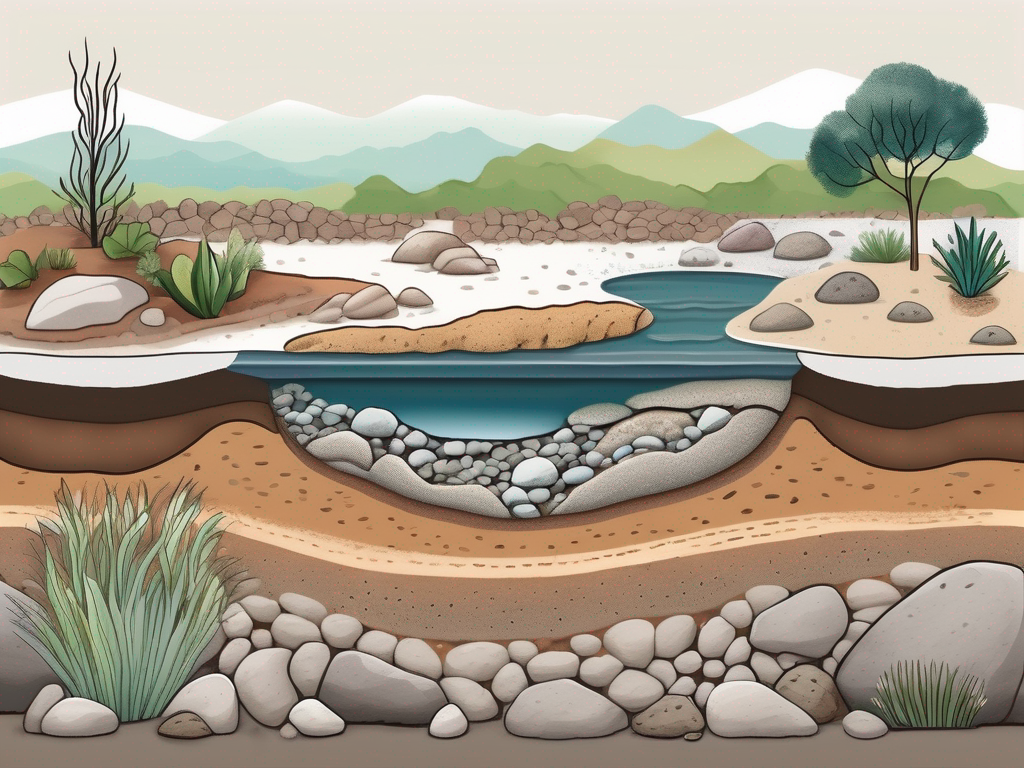
What Is Sediment: A Comprehensive Guide
Sediment is a common term that refers to the particles of organic or inorganic matter that are transported by wind, water, or ice and settle at the bottom of bodies of water or on land. Understanding sediment is critical, not only for environmental science but also for various human activities. This guide delves into the intricacies of sediment, its types, formation process, role in ecosystems, and its interaction with human activities.
Understanding the Basics of Sediment
Definition and Types of Sediment
At its core, sediment consists of solid fragments that originate from the weathering and erosion of rocks and minerals. It can also be organic in nature, derived from decomposed plants and animals. Sediment is generally categorized into three primary types: clastic, chemical, and organic.
Clastic sediments are formed from mechanical weathering and consist of fragments of other rocks. Chemical sediments result from the precipitation of minerals from water, while organic sediments are composed largely of biological material. Each type plays a significant role in both geological processes and in the ecosystem. For instance, clastic sediments can vary in size from fine silt to large boulders, influencing the environments in which they are found. Chemical sediments, such as limestone, often form in marine settings where evaporation concentrates minerals, while organic sediments, like peat, are crucial for soil fertility and carbon storage.
The Formation Process of Sediment
The process of sediment formation is a dynamic interplay of various natural forces. Weathering is the initial step, involving the breakdown of larger rocks into smaller particles through physical, chemical, or biological processes. These smaller particles are then transported by agents like water, wind, and ice. The deposition occurs when these transport mechanisms lose energy, causing sediments to settle.
Over time, layers of sediment accumulate, and through compaction and cementation, they can form sedimentary rocks. Understanding these processes is essential for comprehending the geological history and the evolution of landscapes. Additionally, the rate of sedimentation can provide insights into environmental changes over time, such as shifts in climate or sea level. For example, rapid sedimentation can indicate a period of increased rainfall or volcanic activity, while slower rates might suggest stability in the environment. These sedimentary records serve as crucial archives for paleoclimatologists and geologists, helping to reconstruct past ecosystems and understand future trends in sediment dynamics.
The Role of Sediment in Ecosystems
Sediment and Aquatic Life
Sediment plays a vital role in aquatic ecosystems. It serves as a habitat for various organisms, including microorganisms, insects, and fish. Certain types of sediment, such as fine silt, can provide rich nutrients that promote biodiversity. These sediments are often teeming with life, as they create microhabitats where organisms can thrive, feeding on organic matter and contributing to the overall health of the ecosystem.
However, excessive sedimentation may also have negative effects. High levels of sediment can smother aquatic habitats, reducing light penetration and hindering photosynthesis in aquatic plants. This reduction in light can lead to a decline in plant populations, which are crucial for oxygen production and serve as a food source for many aquatic species. Additionally, the accumulation of sediment can disrupt the spawning grounds of fish, leading to decreased fish populations. Thus, a balanced sediment composition is crucial for maintaining healthy aquatic ecosystems, ensuring that both flora and fauna can flourish.
Sediment's Impact on Soil Fertility
In terrestrial ecosystems, sediment contributes to soil formation and fertility. The nutrients found in sediment are critical for plant growth. Sediments carry essential minerals like phosphorus and nitrogen, which are vital for vegetation. The interaction between sediment and soil organisms, such as earthworms and mycorrhizal fungi, further enhances nutrient availability, promoting robust plant health and growth. This symbiotic relationship is essential for the sustainability of ecosystems, as it helps maintain the nutrient cycle.
However, the excessive deposition of sediment in agricultural fields can lead to soil degradation, altering the pH balance and reducing crop yields. The loss of topsoil due to erosion can also strip away the most fertile layers of soil, making it increasingly difficult for crops to thrive. Moreover, sediment runoff from construction sites or deforested areas can introduce pollutants into the soil, further complicating the issue. Therefore, understanding the interplay between sediment and soil health is vital for sustainable agriculture, as farmers must implement practices that minimize erosion and maintain soil integrity to ensure long-term productivity.
Sediment and Human Activity
Sediment in Construction and Infrastructure
Human activities significantly influence sediment dynamics. In construction, sediment is often disturbed, leading to erosion and the movement of soil particles. This can pose challenges such as sediment runoff into nearby waterways, which can result in pollution and habitat destruction. The impact of sediment runoff is particularly pronounced in urban areas where impervious surfaces, like asphalt and concrete, prevent water absorption, exacerbating the speed and volume of runoff. This not only contributes to sedimentation in rivers and lakes but also increases the risk of flooding, as water is unable to infiltrate the ground.
To mitigate these impacts, techniques like sediment control measures are implemented. These include silt fences, sediment basins, and proper drainage systems that help manage sediment flow and reduce environmental degradation. Additionally, the use of vegetation and natural barriers can enhance these efforts by stabilizing soil and absorbing excess water. Educating construction teams and local communities about the importance of sediment control can further enhance these strategies, leading to more sustainable building practices that protect surrounding ecosystems.
The Role of Sediment in Water Treatment
Sediment also plays a crucial role in water treatment processes. In natural water systems, sediments can act as filters, trapping pollutants and improving water quality. While this can be beneficial, high sediment loads can overwhelm treatment facilities, making it challenging to provide clean water. The accumulation of sediments can lead to clogged filters and increased operational costs for water treatment plants, necessitating more frequent maintenance and potentially compromising the efficiency of the treatment process.
Consequently, understanding sediment management in relation to water treatment is essential for maintaining healthy water supplies and protecting public health. Innovative approaches, such as the use of constructed wetlands and sedimentation ponds, are being explored to enhance the natural filtration capabilities of sediments while also providing additional ecological benefits. Furthermore, ongoing research into sediment transport and deposition patterns can help inform better management practices, ensuring that water treatment systems are equipped to handle the challenges posed by sediment in both urban and rural settings.
Sediment Management and Conservation
Techniques for Sediment Control
Managing sediment is crucial in preserving ecological balance and preventing environmental issues. Various techniques for sediment control have been developed over the years. These include sediment traps, vegetative buffer strips, and contour farming, which all aim to reduce erosion and sediment runoff. Sediment traps, for instance, are designed to capture and store sediment before it can enter water bodies, thereby protecting aquatic ecosystems from excessive sedimentation that can smother habitats and disrupt the food chain. Vegetative buffer strips, on the other hand, utilize native plants to absorb and filter runoff, effectively stabilizing soil and promoting biodiversity.
Implementing these techniques requires collaboration among engineers, environmental scientists, and landowners to ensure effective sediment management strategies that suit local conditions and address specific challenges. This multidisciplinary approach fosters innovation and allows for the sharing of best practices that can be adapted to various landscapes. Moreover, community involvement is vital; educating local populations about the importance of sediment control can lead to grassroots initiatives that further enhance conservation efforts, making sediment management a shared responsibility that benefits everyone.
The Importance of Sustainable Sediment Management
Sustainable sediment management is essential for conserving natural resources and maintaining ecosystem health. It involves practices that minimize the negative environmental impacts associated with sediment loss and deposition. By focusing on sustainable methods, we can mitigate the effects of urbanization and agriculture, which often exacerbate sedimentation issues. For example, integrating green infrastructure, such as rain gardens and permeable pavements, can significantly reduce runoff and promote natural filtration processes, thereby enhancing the resilience of urban landscapes against erosion.
Effective sediment management can lead to improved water quality, enhanced soil fertility, and healthier aquatic habitats. Strategies that focus on sustainability not only benefit the environment but also have positive implications for human activities and economic development. Healthy ecosystems contribute to tourism, recreation, and fisheries, which are vital for local economies. Furthermore, sustainable sediment management practices can help in mitigating the impacts of climate change by preserving carbon sinks in wetlands and forests, thus playing a crucial role in global efforts to combat environmental degradation and promote resilience in the face of changing climatic conditions.
The Future of Sediment Study
Current Research and Innovations in Sedimentology
The field of sedimentology is continually evolving, with research focusing on better understanding sediment processes and their implications for the environment. Innovative technologies such as remote sensing and advanced modeling techniques are being utilized to track sediment movement and deposition patterns more accurately. These advancements not only allow for real-time monitoring of sediment dynamics but also enable researchers to visualize sediment transport in complex environments, such as river deltas and coastal zones, where traditional methods may fall short.
Researchers are also exploring the interactions between sediment and climate change, which could have significant implications for future sediment management strategies. This progressive approach aims to enhance our knowledge and inform policies that promote resistance against environmental changes. For instance, studies are being conducted on how rising sea levels and increased storm intensity affect sediment redistribution, which in turn impacts coastal ecosystems and infrastructure. By integrating sedimentology with climate science, scientists are better equipped to predict and mitigate the adverse effects of climate change on both natural and human systems.
Predicted Trends in Sediment-Related Fields
In the coming years, it is anticipated that the study of sediment will intersect with various scientific fields, including ecology, geology, and hydrology, leading to more interdisciplinary approaches. Increased attention is likely to be given to the influence of human activities on natural sediment processes and the subsequent impacts on biodiversity. For example, urbanization and agriculture can drastically alter sediment flow, leading to erosion and habitat loss. As such, sedimentology will play a crucial role in understanding these changes and developing strategies to restore affected ecosystems.
Furthermore, as environmental concerns grow, sustainable sediment management methodologies will gain prominence, influencing policy-making and conservation efforts. Understanding these trends is vital for those interested in the intersection of science, conservation, and human impact. The integration of sediment studies into broader environmental management frameworks will likely encourage collaborative efforts among scientists, policymakers, and local communities. This collaboration is essential for creating effective sediment management plans that not only address immediate environmental challenges but also promote long-term ecological resilience and sustainability.
